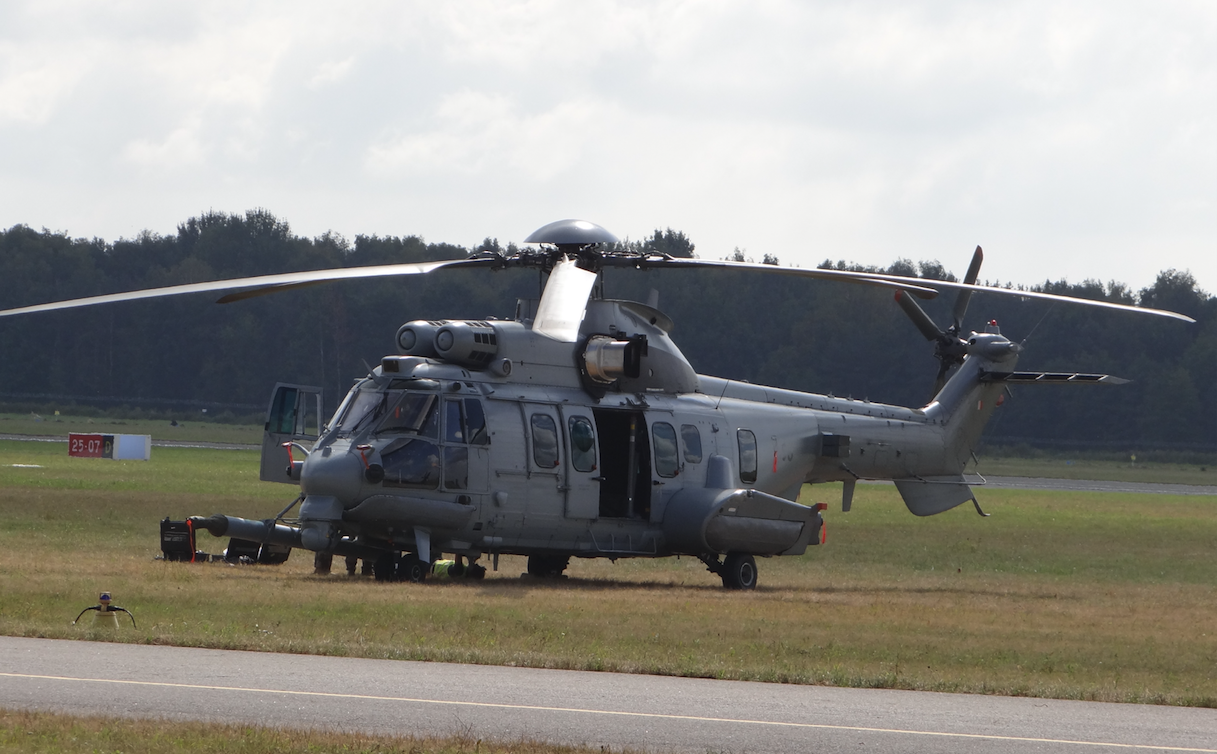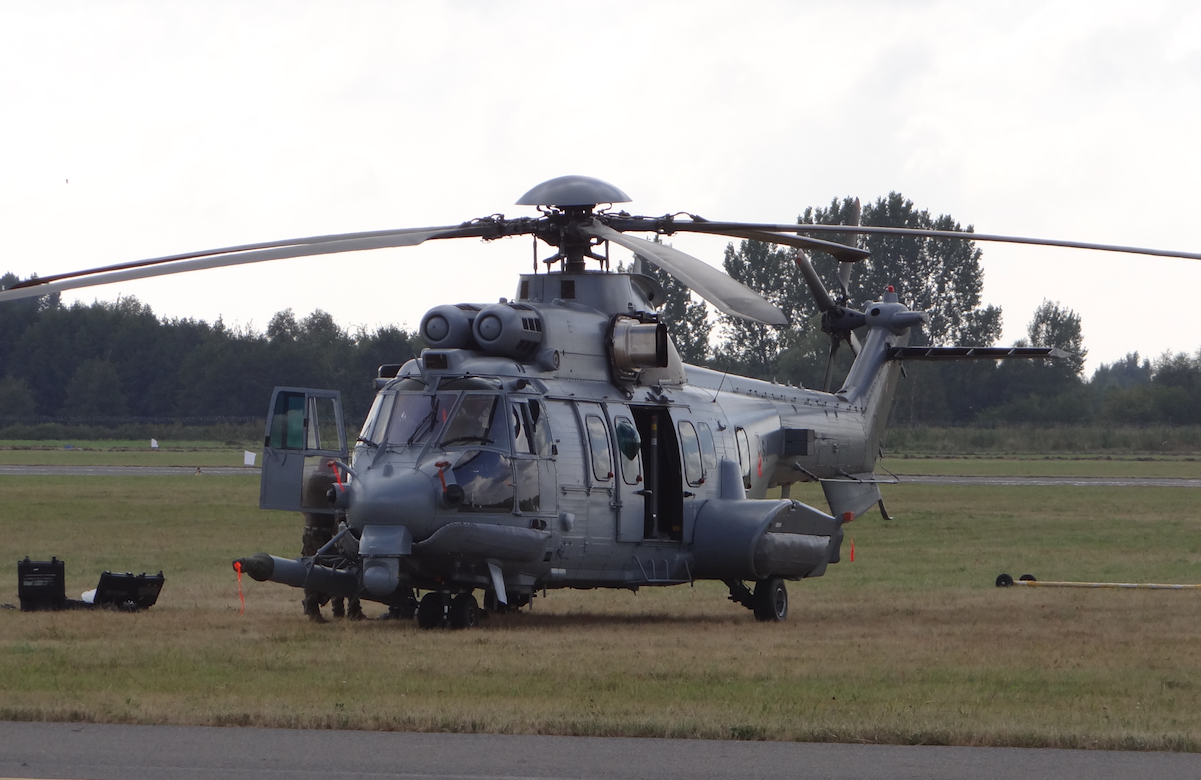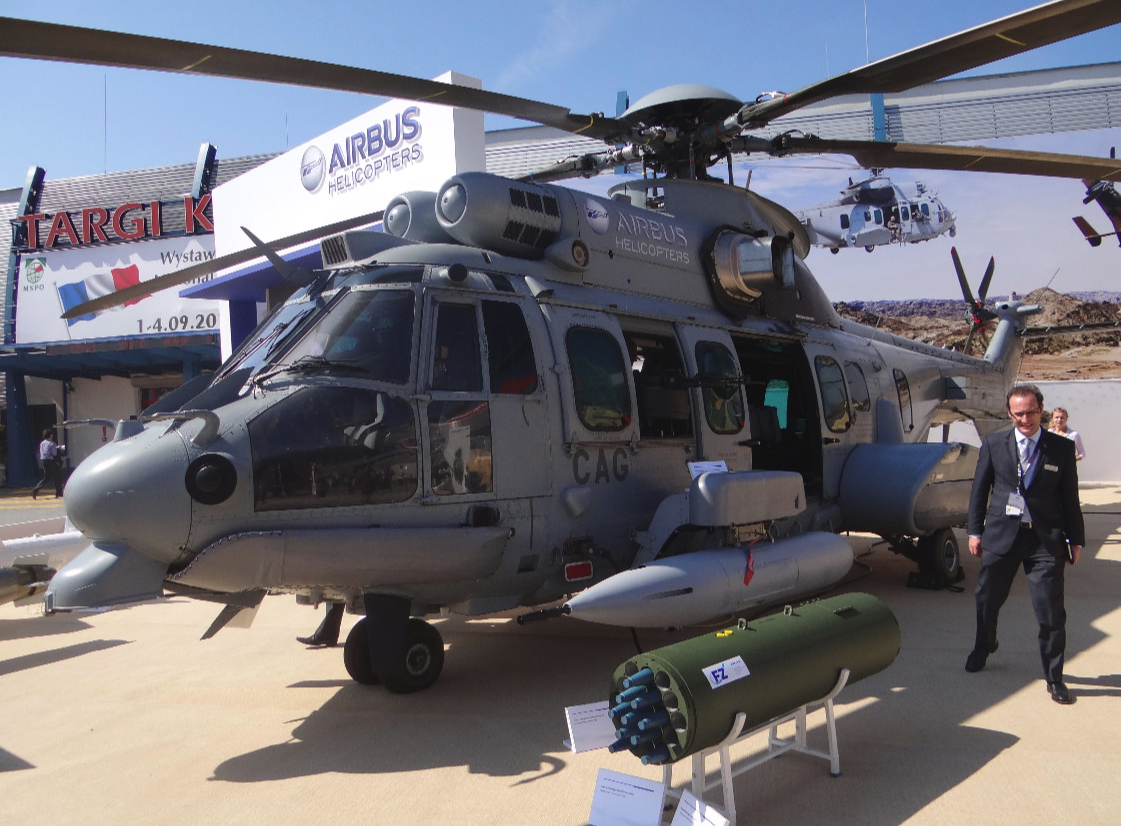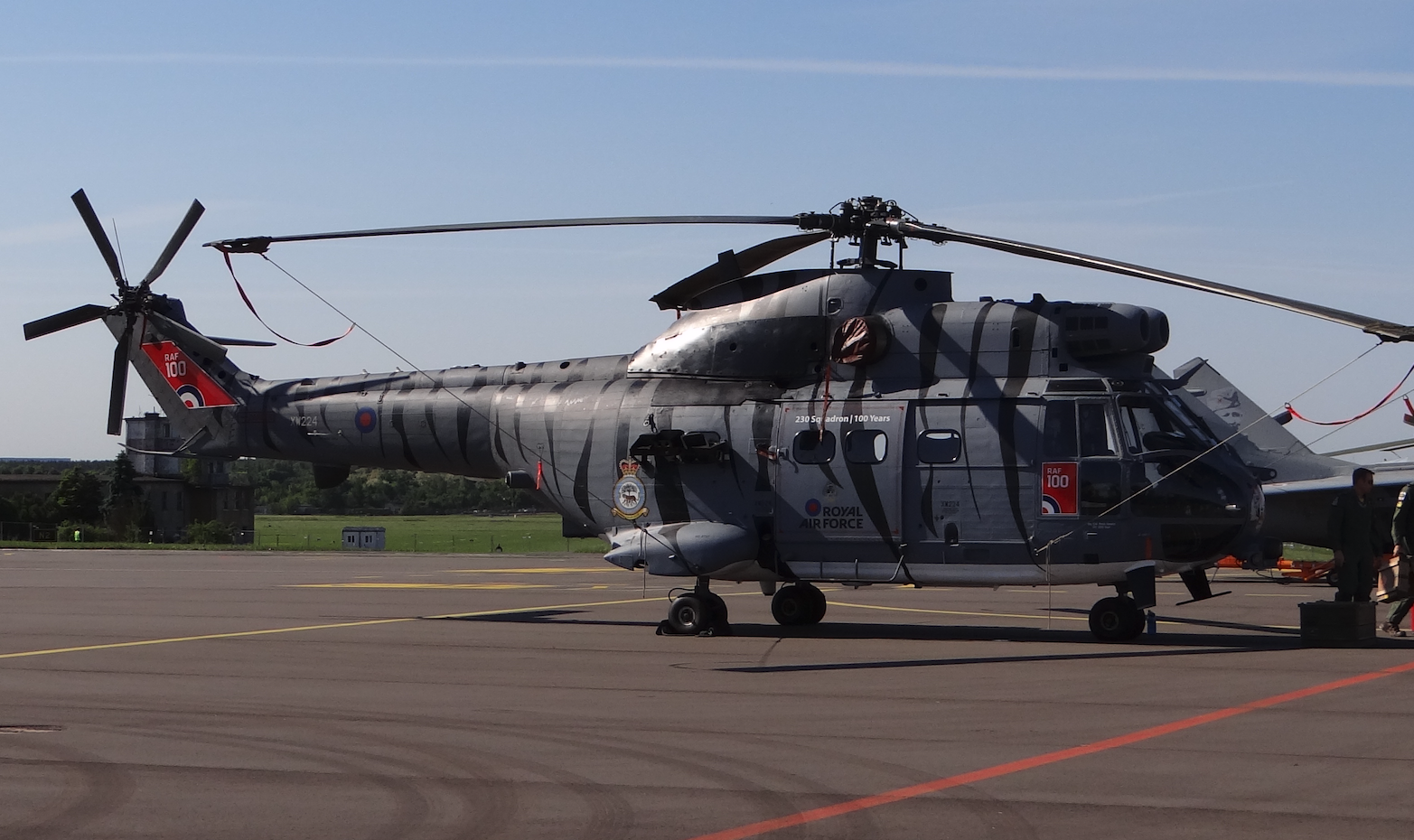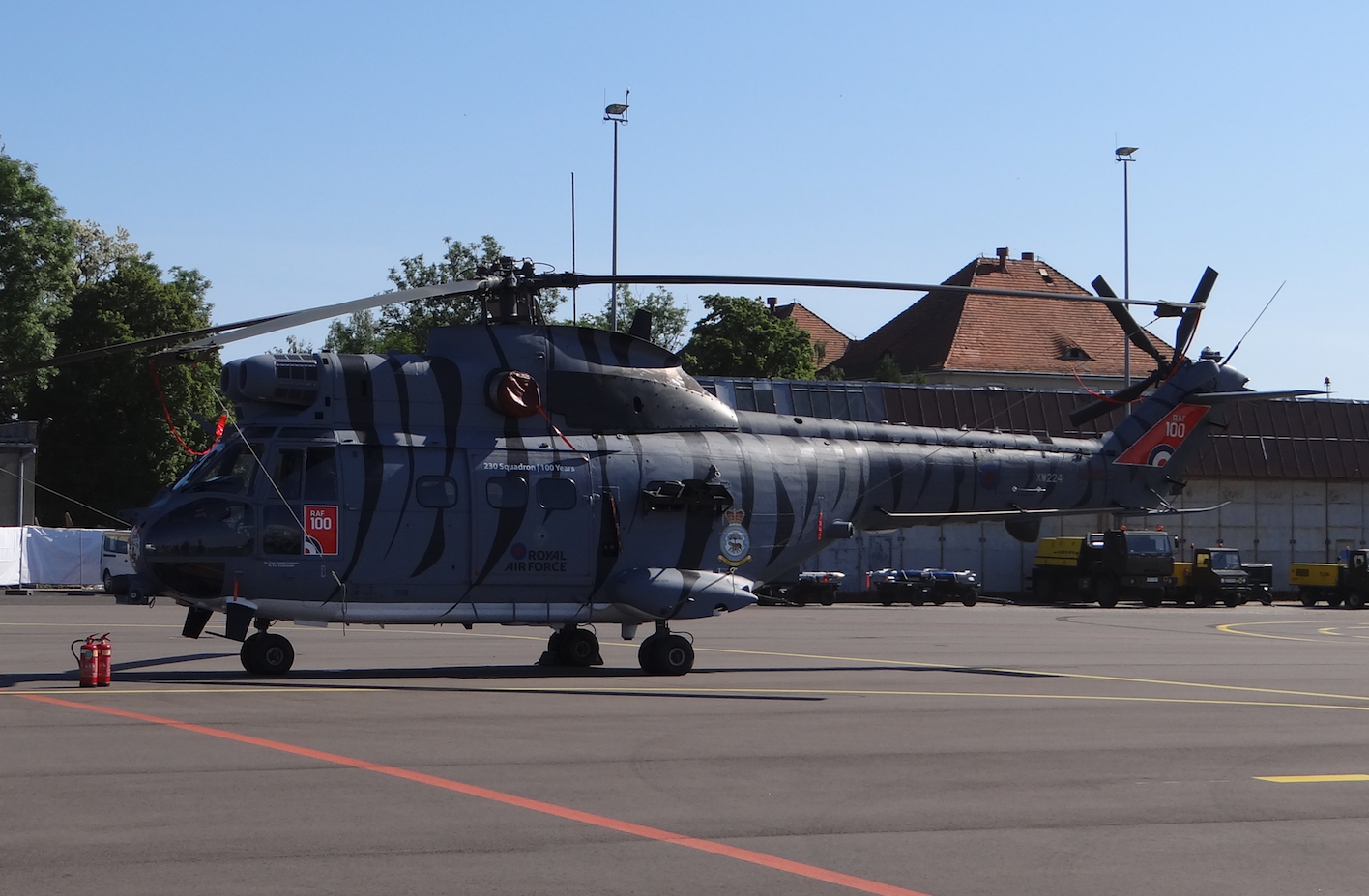Warszawa 2018-05-29
Airbus Helicopters H.225 Caracal.
319a Section 2013 year. Poland.
History.
The Airbus Helicopters H.225M Caracal (also called Super Cougar), previously named Eurocopter EC.725 Caracal, is a long-range tactical military transport helicopter developed from the previous Eurocopter AS.532 design for military use.
It is a twin-engine helicopter with two pilots on board and can carry up to 29 fully armed soldiers, depending on the configuration chosen by the customer. The helicopter is used for troop transport, military equipment, accident evacuation and search and rescue and is similar to the civilian EC.225. The civil EC.225 is used to transport people and goods.
Caracal program.
The new helicopter was developed to meet the French Air Force’s requirement for a specialized helicopter for combat, search and rescue operations.
The AS.532 A2 Cougar model was tested and, after extensive trials in 1996-1999, was not accepted for production and service. The military demanded that the structure be improved. The main improvements desired by the French Air Force were more powerful engines, better flight characteristics and increased combat endurance. Eurocopter decided to develop a more ambitious AS.532-derived design to meet these demands.
The new design was designated EC.725. The EC.725 helicopter initially had its own name Cougar Mk II+. Highlights include a fuel tank capacity of 3,750 liters / 990 gallons, giving the helicopter a flight time of 5 hours 30 minutes, plus aerial refueling capability. The main gear has been strengthened. It features a new 5-blade main rotor, 4-axis autopilot, guidance system for emergency locator beacons, mounted armor and integrated protection. The new helicopter uses new mission equipment and autonomous avionics.
On November 27, 2000, the first EC.725 prototype made its maiden flight in Marignane. Marignane is a town in France on the Mediterranean Sea. On January 15, 2001, the first public presentation of the new helicopter took place. With the concurrent development of the military-oriented EC.725, Eurocopter also developed a civilian equivalent, which was designated the EC.225.
The French Air Force initially ordered six EC.725 helicopters for Combat Search & Rescue duties. Cost 15 million euros per copy. The first machine was delivered in February 2005. Another order for eight EC.725s was placed with the French armed forces in November 2002. The helicopter was ordered by: France, Brazil, Indonesia, Kazakhstan, Kuwait, Malaysia, Singapore, Mexico, Thailand and India. EC 725 operators (except French Air Force and Navy) include Brazilian Air Force, Navy, Army and Government, Kazakhstan Air Force, Indonesian Air Force, Royal Saudi Air Force, Royal Malaysian Air Force and Mexican Air Force. About 30 machines are in use.
The H.225M helicopter was produced on two separate production lines in France and Brazil.
Series model variants:
H.725 – Designation of the series under the Airbus Helicopters brand.
EC.725 "Caracal" ("Super Cougar") – The designation of the basic series under the Eurocopter brand; the helicopter is designed for military transport.
EC.725 VIP – VIP transport with seating for up to 12 people.
EC.725 MEDEVAC – Medical evacuation model with space for 12 x stretchers and 4 medical tripods.
EC.725 SAR – Search and Rescue variant equipped with appropriate equipment for rescuing people.
In 2017, the French Ministry of Defense reported that over 75% of Caracal helicopters were grounded. Why? Their repair is too expensive. In the last four years, the cost of repairing them has doubled.
Airbus Caracal for the Polish Army.
In the spring of 2012, the Ministry of National Defense announced a tender for helicopters for everything. The first purchase of 26 machines was declared. The purchase of one platform in three variants was considered: transport, anti-submarine warfare (ZOP) and combat search and rescue (CSAR).
Unexpectedly, in September 2012, Prime Minister Donald Tusk announced that not 26 machines, but as many as 70 helicopters would be purchased for the needs of the armed forces. But still based on one type. It was one of thousands of promises from a liberal prime minister who promised everything. Officially, the Armament Inspectorate on its website announced the correction of the procedure only in February 2013. Even then, it was unofficially known that the Airbus Caracal helicopter was the winner.
For the fictitious tender, apart from the consortium "EC725 Program Caracal Polska" composed of: Airbus Helicopters, Heli Invest Sp. z o.o., offering the EC725/H225 Caracal helicopter, two more platforms were offered: a consortium consisting of: Sikorsky International Operations Inc., Sikorsky Aircraft Corporation, Polskie Zakłady Lotnicze Sp. z o. o., offering Polish-made S-70i Black Hawk and S-70B Seahawk helicopters, and Wytwórnia Sprzętu Komunikacji PZL-Świdnik S.A., offering AW 149 helicopters.
The tactical and technical requirements (WTT), which were written for the needs of the tender, remained a mystery. They have not been formally disclosed, but the fact that such different helicopters as the AW 149 and H225 may have been involved in the proceedings reflects badly on the transparency of the proceedings.
At the same time, the privatization proceedings of the aviation sector in Poland, including the helicopter production plants, were under way. First, on March 16, 2007, 100% of shares in Polskie Zakłady Lotnicze Sp. z o. o. was purchased from ARP S.A. by United Technologies Holdings S. A. (UTH), a company of United Technologies Corporation (UTC). As part of the UTC concern, direct cooperation with PZL Mielec was undertaken by a UTC group company – Sikorsky Aircraft Corporation. Then, in 2010, WSK PZL Świdnik S.A. were eventually acquired by the AgustaWestland concern, belonging to the Finmeccanica holding company, and now Leonardo. The privatization of the plants obviously had a huge impact on the ongoing proceedings. Both plants, understandably, applied for the tender. Their competitor was Airbus Helicopters.
It is worth mentioning here that the Polish Army did not agree with the position of the Ministry of National Defense. The military saw the need only to replace the Mil Mi-8 and Mil Mi-17 helicopters, and this is because smaller helicopters are produced in the country. They demanded a helicopter with a rear loading ramp. The offered Caracal does not have it. The Polish Army counted on Sikorsky S-92 or NHI NH-90 helicopters. But the decision-makers did not notice this request. Time requirements set by the Polish side meant that these machines were not offered. There was also the issue of price, but in this case, shopping could be extended over time.
After choosing the Caracal helicopter, it turned out that it became very expensive and only 50 copies could be purchased for PLN 13.4 billion. The offset was to consist in the production of main rotor blades at WZL No. 2 in Łódź, i.e. in a plant that specializes in the repair of military helicopters. Airbus withdrew from the possible offer of final assembly of helicopters in Łódź.
In May 2016, in the Sejm of the Republic of Poland, the Minister of National Defense, Antoni Macierewicz, presented a report on the audit in the Ministry of National Defense. It was devastating for the former rulers – Civic Platform and Polish People’s Party. Antoni Macierewicz said, among other things, to the former rulers – "What has Poland done to you that you left it so defenseless?" And further – "Planning the development of the armed forces was based on a fixed number of battalions capable of directly conducting a defensive operation. At the same time, neither the data on the growth of the hypothetical potential of the enemy, nor the issue of recovering losses in the course of possible defensive operations were taken into account. Such planning can hardly be called simple incompetence. It was a conscious act to the detriment of the Polish state." The head of the Ministry of National Defense said that in the years 2010-2015 PLN 50 billion was spent on the implementation of development programs for the Armed Forces. – “None of the programs for which the PLN 50 billion was spent at that time, neither then nor to this day has been completed. What happened to this money, I ask you from PO and PSL, where did PLN 50 billion go? Let’s add to the fact that only PLN 2 billion per year flowed to Polish enterprises, the rest was spent on foreign enterprises. And further "- The program of modernization of the armed forces has been misleading the public from the very beginning" – said the head of the Ministry of National Defence. The minister said that the decisions of his predecessors in the Ministry of National Defense – Bogdan Klich and Tomasz Siemoniak on defining the procedures for obtaining armament and military equipment did not serve the purpose of transparency in spending public funds, but – were an instrument of conscious and intentional blurring of traces and blurring the responsibility of people planning and conducting purchases.
On October 4, 2016, the decision to abandon the acquisition of Caracal multi-role helicopters was announced. "Poland considers the negotiations on the offset agreement with Airbus Helicopters regarding the contract for the purchase of Caracal helicopters to be completed, further talks are pointless." – announced on Tuesday, October 4, 2016, the Ministry of Development in a communiqué.
Airbus Helicopters H.225M Caracal / Eurocopter EC.725 Caracal design.
The helicopter is a medium-sized H225M helicopter (11 tons), which is a member of the Cougar family of helicopters developed by Eurocopter. The helicopter was developed for the army and for civil services. Military version H225M and civil version EC 225. The EC.725 helicopter is based on the Eurocopter AS.532 Cougar helicopter, improving its design by installing a five-bladed composite main rotor with a new blade shape to reduce vibration levels.
The helicopter is powered by two Turbomeca Makila 1A4 turboshaft engines, mounted above the cabin, which are equipped with a dual-channel Full Authority digital engine control (FADEC) system. An in-flight refueling probe could be mounted on the aircraft’s forward starboard side for in-flight refueling, greatly extending operating ranges. The Caracal is equipped with an anti-icing system, allowing the helicopter to operate in cold climates. The helicopter has a glass cockpit. The cockpit is equipped with an integrated display system with a digital map and Active Matrix liquid crystal displays.
Eurocopter has developed four basic cabin configurations for this type. The Transport Troop version takes up to 29 soldiers. The special version of the VIP transport takes 8 to 12 passengers on board. The helicopter has day and night search and rescue capabilities with search and Forward Looking Infra Red (FLIR) radar.
Armament.
The EC.725 can be fitted with various armaments, for example: a pair of 7.62 mm FN MAG machine guns mounted in the front left and right windows, or a pair of 68 mm (2.75") Thales Brandt or Forges de Zeebrugge rocket launchers mounted, each with 19 missiles or an MU90 Impact launcher.The helicopter also has defense systems.The armament depends on the user’s requirements.
The usual armament is: 2 x 7.62 mm Fabrique Nationale FN MAG machine guns, window mount machine guns. Armored pods 2 x 19 68 mm rocket pods on the outer side mounts. 2 x 20mm GIAT cannon pods on outer side mounts.
Technical data (EC.725 Caracal):
Crew 1 or 2 (pilot + co-pilot). Capacity up to 29 troops or 5,670 kg of cargo. Length 19.5 m (64 ft 0 in). Height 4.6 m (15 ft 1 in). Curb weight 5,330 kg (11,751 lb). Takeoff weight 11,000 kg (24,251 lb). Max takeoff weight 11,200 kg (24,692 lb). Powerplant, 2 × Turboméca Makila 2A1 turbine engines, 1,776 kW (2 x 2,382 hp). Main rotor diameter: 16.20 m (53 ft 2 in). Rotor drive wheel: 206.1 m2 (2,218 sq ft).
Top speed 324 km/h (201 mph, 175 kn) in level flight. Cruise speed 285 km/h (177 mph, 154 kn). Critical top speed 324 km/h (201 mph, 175 kn). Range 857 km (533 mi, 463 nmi). Ferrying range 1,315 km (823 mi, 715 mi). Service ceiling 6,095 m (19,997 ft). Rate of climb 7.4 m/s (1,460 ft/min).
Airbus Helicopters H.225M Caracal / Eurocopter EC.725 Caracal Comparison.
It was planned to buy 26 machines, then 70 machines, then 50, and as a result, none was bought.
Written by Karol Placha Hetman

